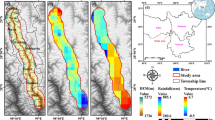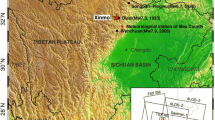Abstract
This study aims to detect recent landslide displacements caused by geological structure of the region where there is intense urbanization using advanced Interferometric Synthetic Aperture Radar (InSAR) techniques and with Global Navigation Satellite Systems (GNSS) observations in the Beylikdüzü and Esenyurt districts in Istanbul megacity, Turkey. In this study, multiple satellites with different frequencies (C-band, L-band) and periodic GNSS observations were employed. For the entire peninsula, we processed 149 images from the ascending orbit, 144 images from the descending orbit of Sentinel-1 (C-Band) and 24 ALOS-2 (L-band) images from the ascending orbit. The evaluations were carried out in the period between 2015 and 2020 for Sentinel-1 imagery and 2015–2020 for ALOS-2 imagery respectively. Since the study area is covered by dense settlements, the Persistent Scatterer InSAR (PSI) technique was utilized to determine the landslide behaviors. According to the results, for both orbits of the Sentinel-1, the horizontal displacement and the vertical displacement were observed in the range of − 10 to 6 mm. Compared to the magnitude of displacement signal measured by Sentinel-1, ALOS-2 data has higher values due to the high surface penetration of the L-band. The results showed that most of the old landslide regions are reactivated. Horizontal movement derived through Sentinel-1 showed that the highest movement overlaps with old landslides. L-band ALOS-2 provided better spatial coverage of landslide movement than C-band Sentinel-1 data, especially at the rural part along the coast of the lake.












Similar content being viewed by others
References
Abdikan S, Arıkan M, Sanli FB, Cakir Z (2014) Monitoring of coal mining subsidence in peri-urban area of Zonguldak city (NW Turkey) with persistent scatterer interferometry using ALOS-PALSAR. Environ Earth Sci 71:4081–4089. https://doi.org/10.1007/s12665-013-2793-1
Akar I, Uysal C, Maktav D (2008) Determination of natural disaster by integration of remote sensing and GIS: the Yeniçiftlik stream basin model in Istanbul, Turkey. In: Proceeding of the the XXIth ISPRS Congress, Beijin, China
Akarvardar S, Feigl KL, Ergintav S (2009) Ground deformation in an area later damaged by an earthquake: monitoring the Avcilar district of Istanbul, Turkey, by satellite radar interferometry 1992–1999. Geophys J Int 178:976–988. https://doi.org/10.1111/j.1365-246X.2009.04126.x
Arıkan M, Hooper A, Hanssen R (2010) Large-scale tectonics in western Anatolia from time series InSAR. In: 7th EGU General Assembly 2010, Vienna 12, EGU2010-13909
Arikan M, Hooper A, Hanssen R (2010) Radar time series analysis over West Anatolia European Space Agency (Special Publication) ESA SP-677
Arıkan M, Hooper A, Caro Cuenca M, Hanssen R (2011) Recent tectonic activity over the Marmara Sea region from time series InSAR. In: Advances in the science and applications of SAR interferometry and Sentinel-1 preparatory workshop, fringe 2011, Franscati, Italy, pp 19–23 September, ESA 2011
Arpar E (1999) General characteristics of Büyükçekmece and Küçükçekmece (Istanbul) landslides and the main problems they created (In Turkish). In: Proceedings of the 52, Turkey Geological Congress, pp 17–23
Aslan G, Cakır Z, Ergintav S et al (2018) Analysis of secular ground motions in Istanbul from a long-term InSAR time-series (1992–2017). Remote Sens. https://doi.org/10.3390/rs10030408
Berardino P, Fornaro G, Lanari R, Sansosti E (2002) A new algorithm for surface deformation monitoring based on small baseline differential SAR interferograms. IEEE Trans Geosci Remote Sens 40:2375–2383. https://doi.org/10.1109/TGRS.2002.803792
Bourdeau C, Lenti L, Martino S et al (2017) Comprehensive analysis of the local seismic response in the complex Büyükçekmece landslide area (Turkey) by engineering-geological and numerical modelling. Eng Geol 218:90–106. https://doi.org/10.1016/j.enggeo.2017.01.005
Calò F, Ardizzone F, Castaldo R et al (2014) Enhanced landslide investigations through advanced DInSAR techniques: the Ivancich case study, Assisi, Italy. Remote Sens Environ 142:69–82. https://doi.org/10.1016/j.rse.2013.11.003
Calò F, Abdikan S, Görüm T et al (2015) The space-borne SBAS-DInSAR technique as a supporting tool for sustainable urban policies: the case of Istanbul Megacity, Turkey. Remote Sens 7:16519–16536. https://doi.org/10.3390/rs71215842
Chen Y, Zhang K, Froger J-L et al (2018) Long-term subsidence in lava fields at Piton de la Fournaise volcano measured by InSAR: new insights for interpretation of the Eastern Flank motion. Remote Sens. https://doi.org/10.3390/rs10040597
Cigna F, Bateson LB, Jordan CJ, Dashwood C (2014) Simulating SAR geometric distortions and predicting persistent scatterer densities for ERS-1/2 and ENVISAT C-band SAR and InSAR applications: nationwide feasibility assessment to monitor the landmass of Great Britain with SAR imagery. Remote Sens Environ 152:441–466. https://doi.org/10.1016/j.rse.2014.06.025
Coccia S, Theoleyre F, Bigarre P, et al (2014) Advancements in near real time mapping of earthquake and rainfall induced landslides in the Avcilar Peninsula, Marmara Region. In: EGU general assembly conference abstracts, p 14507
Dach R, Lutz S, Walser P, Fridez P (2015) Bernese GPS software version 5.2. Astronomical Institute, University of Bern, Bern
Dai K, Liu G, Li Z et al (2015) Extracting vertical displacement rates in Shanghai (China) with multi-platform SAR images. Remote Sens 7:9542–9562. https://doi.org/10.3390/rs70809542
Diao F, Walter TR, Minati F et al (2016a) Secondary fault activity of the North Anatolian Fault near Avcilar, southwest of Istanbul: evidence from SAR interferometry observations. Remote Sens. https://doi.org/10.3390/rs8100846
Diao F, Walter TR, Solaro G et al (2016b) Fault locking near Istanbul: Indication of earthquake potential from InSAR and GPS observations. Geophys Suppl to Mon Not R Astron Soc 205:490–498. https://doi.org/10.1093/gji/ggw048
Dogan U, Oz D, Ergintav S (2013) Kinematics of landslide estimated by repeated GPS measurements in the Avcilar region of Istanbul, Turkey. Stud Geophys Geod 57:217–232. https://doi.org/10.1007/s11200-012-1147-x
Dreger DS, Huang M, Rodgers A et al (2015) Kinematic finite-source model for the 24 August 2014 South Napa, California, earthquake from joint inversion of seismic, GPS, and InSAR data. Seismol Res Lett 86:327–334. https://doi.org/10.1785/0220140244
Duman TY, Can T, Ulusay R et al (2005) A geohazard reconnaissance study based on geoscientific information for development needs of the western region of Istanbul (Turkey). Environ Geol 48:871–888. https://doi.org/10.1007/s00254-005-0026-y
Duman TY, Can T, Gokceoglu C et al (2006) Application of logistic regression for landslide susceptibility zoning of Cekmece Area, Istanbul, Turkey. Environ Geol 51:241–256. https://doi.org/10.1007/s00254-006-0322-1
Duman TY, Can T, Emre Ö (2011) 1/1500000 scaled Turkey landslide inventory map (In Turkish). General directorate of mineral research and exploration (MTA), Special Publications Series-27, Ankara, Turkey. ISBN: 978-605-4075-84-3
Einfalt T, Keskin F (2010) BALWOIS 2010 scientific conference on water observation and information system for decision support; ministry of environment and physical planning of Republic of Macedonia. Republic of Macedonia, Ohrid
Ergintav S, Demirbağ E, Ediger V et al (2011) Structural framework of onshore and offshore Avcılar, Istanbul under the influence of the North Anatolian fault. Geophys J Int 185:93–105. https://doi.org/10.1111/j.1365-246X.2011.04941.x
Erten E, Rossi C (2019) The worsening impacts of land reclamation assessed with Sentinel-1: the Rize (Turkey) test case. Int J Appl Earth Obs Geoinf 74:57–64. https://doi.org/10.1016/j.jag.2018.08.007
Ferretti A, Prati C, Rocca F (2000) Nonlinear subsidence rate estimation using permanent scatterers in differential SAR interferometry. IEEE Trans Geosci Remote Sens 38:2202–2212. https://doi.org/10.1109/36.868878
Ferretti A, Prati C, Rocca F (2001) Permanent scatterers in SAR interferometry. IEEE Trans Geosci Remote Sens 39:8–20. https://doi.org/10.1109/36.898661
Frey O, Werner CL, Caduff R, Wiesmann A (2016) A time series of tomographic profiles of a snow pack measured with SnowScat at X-/Ku-band. In: 2016 IEEE international geoscience and remote sensing symposium (IGARSS). IEEE, pp 17–20. https://doi.org/10.1109/IGARSS.2016.7728995
Görüm T, Nefeslioğlu H (2015) A geomorphological approach to the identification of multi-temporal landslide activity (In Turkish). Türk Coğrafya Dergisi, pp 47–58
Hastaoglu KO, Poyraz F, Turk T et al (2018) Investigation of the success of monitoring slow motion landslides using persistent scatterer interferometry and GNSS methods. Surv Rev 50:475–486. https://doi.org/10.1080/00396265.2017.1295631
Hooper A (2008) A multi-temporal InSAR method incorporating both persistent scatterer and small baseline approaches. Geophys Res Lett. https://doi.org/10.1029/2008GL034654
Hooper A, Zebker H, Segall P, Kampes B (2004) A new method for measuring deformation on volcanoes and other natural terrains using InSAR persistent scatterers. Geophys Res Lett. https://doi.org/10.1029/2004GL021737
Hooper A, Bekaert D, Spaans K, Arıkan M (2012) Recent advances in SAR interferometry time series analysis for measuring crustal deformation. Tectonophysics 514:1–13. https://doi.org/10.1016/j.tecto.2011.10.013
Kampes BM (2006) Radar interferometry—persistent scatterer technique. Springer. ISBN-10 1-4020-4576-X
Lenti L, Martino S, Musolino G (2017) Considering seismic coefficient distributions within slopes to calculate landslide reactivation probability. Bull Eng Geol Environ 76:1353–1370. https://doi.org/10.1007/s10064-016-0938-7
Lippl S, Vijay S, Braun M (2018) Automatic delineation of debris-covered glaciers using InSAR coherence derived from X-, C-and L-band radar data: a case study of Yazgyl Glacier. J Glaciol 64:811–821. https://doi.org/10.1017/jog.2018.70
Maktav D, Sunar F, Taberner M, Akgün H (2000) Monitoring urban expansion in the Büyükçekmece district of Istanbul using satellite data. Int Arch Photogramm Remote Sens 33:1484–1492
Meral Ozel N, Necmioǧlu Ö, Ergintav S et al (2016) New directions in seismic hazard assessment through focused earth observation in the MARmara superSITE-project achievements. In: EGU general assembly conference abstracts, pp EPSC2016–15122
Nefeslioglu HA, Sezer E, Gokceoglu C et al (2010) Assessment of landslide susceptibility by decision trees in the metropolitan area of Istanbul. Turkey Math Probl Eng. https://doi.org/10.1155/2010/901095
Özgül N et al (2011) Geology of Istanbul Provincial Area: Istanbul Metropolitan Municipality (In Turkish), p 308
Reilinger RE, Ergintav S, Bürgmann R et al (2000) Coseismic and postseismic fault slip for the 17 August 1999, M= 7.5, Izmit, Turkey earthquake. Science 289:1519–1524. https://doi.org/10.1126/science.289.5484.1519
Ryder I, Parsons B, Wright TJ, Funning GJ (2007) Post-seismic motion following the 1997 Manyi (Tibet) earthquake: InSAR observations and modelling. Geophys J Int 169:1009–1027. https://doi.org/10.1111/j.1365-246X.2006.03312.x
Schmidt DA, Bürgmann R (2003) Time-dependent land uplift and subsidence in the Santa Clara valley, California, from a large interferometric synthetic aperture radar data set. J Geophys Res Solid Earth. https://doi.org/10.1029/2002JB002267
TUBITAK (2016) Report, Project no 5137701, Research, investigation and monitoring of various landslide areas in Beylikdüzü and Büyükçekmece Districts (in Turkish). http://www.ibb.gov.tr/tr-TR/SubSites/DepremSite/Documents/heyelantehlikeanalizi.pdf
Turkey Statistics Institute (TUIK) (2019) Exports according to Country groups. http://tuik.gov.tr/UstMenu.do?metod=temelist. Accessed 6 Feb 2019
Walter TR, Manzo M, Manconi A et al (2010) Satellite monitoring of hazards: a focus on Istanbul, Turkey. Eos Trans Am Geophys Union 91:313–314. https://doi.org/10.1029/2010EO360001
Yalcinkaya E, Alp H, Ozel O et al (2016) Near-surface geophysical methods for investigating the Buyukcekmece landslide in Istanbul, Turkey. J Appl Geophys 134:23–35. https://doi.org/10.1016/j.jappgeo.2016.08.012
Yildirim M, Savaşkan E (2003) A new approach to the stratigraphy of the tertiary sedimentary formations in Istanbul and their engineering properties. In: Proceedings of national symposium on, Istanbul’s Geology, Kadir Has University, Cibali, Istanbul, pp 87–102
Acknowledgements
This study is part of first author’s Ph.D. thesis. The authors would like to thank the European Space Agency (ESA) for providing Sentinel-1 data and Japan Aerospace Exploration Agency (JAXA) for providing ALOS-2 data under project 3210. Also, we thank Müslüm Hacar, Hüseyin Duman, Batuhan Kılıç and Zeynel Abidin Polat for assistance with the GNSS observations and thank Ahmet Delen for assistance on InSAR processing steps.
Author information
Authors and Affiliations
Contributions
CB and SA conceived and designed the experiments; CB, SA, AO, MA, FBS, and UD performed the experiments; CB, SA, AO, and MA analyzed the data; CB, SA, AO, and MA contributed analysis and visualization; CB, SA, AO, MA, FBS, and UD wrote the paper.
Corresponding author
Ethics declarations
Conflict of interest
The authors declare no conflict of interest.
Additional information
Publisher's Note
Springer Nature remains neutral with regard to jurisdictional claims in published maps and institutional affiliations.
Rights and permissions
About this article
Cite this article
Bayik, C., Abdikan, S., Ozdemir, A. et al. Investigation of the landslides in Beylikdüzü-Esenyurt Districts of Istanbul from InSAR and GNSS observations. Nat Hazards 109, 1201–1220 (2021). https://doi.org/10.1007/s11069-021-04875-7
Received:
Accepted:
Published:
Issue Date:
DOI: https://doi.org/10.1007/s11069-021-04875-7




